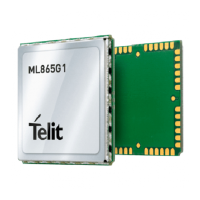ML865G1 HW Design Guide
1VV0301632 Rev. 4 Page 29 of 86 2020-09-23
4.3.1.2. +12V Source Power Supply Design Guidelines
• The desired output for the power supply is 3.8V, hence due to the big difference
between the input source and the desired output, a linear regulator is not suited and
shall not be used. A switching power supply will be preferable because of its better
efficiency.
• When using a switching regulator, a 500kHz or more switching frequency regulator
is preferable because of its smaller inductor size and its faster transient response.
This allows the regulator to respond quickly to the current peaks absorption.
• In any case the frequency and Switching design selection is related to the
application to be developed due to the fact the switching frequency could also
generate EMC interferences.
• For car PB battery the input voltage can rise up to 15,8V and this should be kept in
mind when choosing components: all components in the power supply must
withstand this voltage.
• A Bypass low ESR capacitor of adequate capacity must be provided in order to cut
the current absorption peaks, a 100μF capacitor is usually suited.
• Make sure the low ESR capacitor on the power supply output is rated at least 10V.
• For Car applications a spike protection diode should be inserted close to the power
input, in order to clean the supply from spikes.
An example of switching regulator with 12V input is in the below schematic:
4.3.1.3. Battery Source Power Supply Design Guidelines
The desired nominal output for the power supply is 3.8V and the maximum voltage allowed
is 4.2V, hence a single 3.7V Li-Ion cell battery type is suited for supplying the power to the
Telit ML865G1 module.
• A Bypass low ESR capacitor of adequate capacity must be provided in order to cut
the current absorption peaks, a 100μF tantalum capacitor is usually suited.
• Make sure the low ESR capacitor (usually a tantalum one) is rated at least 10V.
• A protection diode should be inserted close to the power input, in order to save the
ML865G1 from power polarity inversion. Otherwise the battery connector should be
done in a way to avoid polarity inversions when connecting the battery.
• The battery must be rated to supply peaks of current up to 2A.

